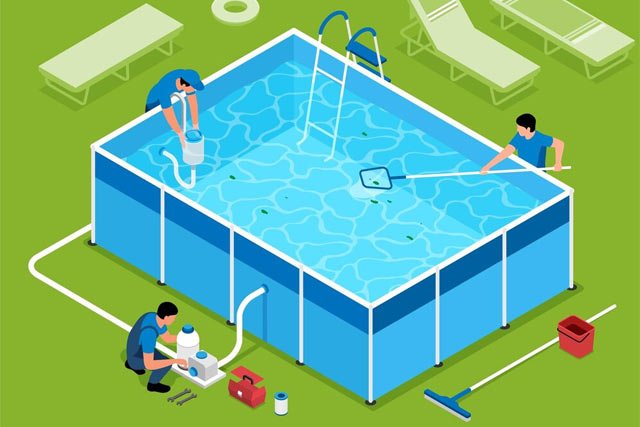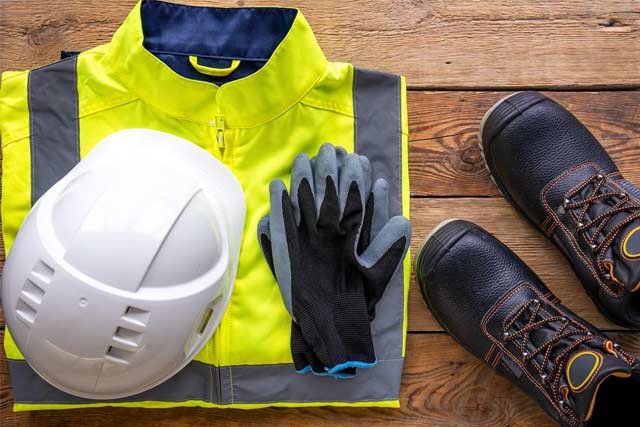
Depending on your location, winterizing your pool might not be necessary. If that’s the case, keeping up with DIY pool care, like regularly checking and testing the water chemistry, remains vital for maintaining your pool’s health.
Also, skim the water’s surface daily, brush frequently, and vacuum according to your manual’s instructions.
1- Daily Skimming

1.1. Consistent Maintenance
Maintaining your pool’s crystal-clear appeal requires consistency. This is especially true during the winter when a lack of routine can cause your pool to deteriorate faster than it would have otherwise. Create a maintenance schedule for each season to ensure you don’t miss important steps. A weekly schedule helps you plan for the most critical activities, like testing and cleaning. It also makes it easier to assign chores to different members of your household, so one person doesn’t get burned out.
Skimming is an essential daily task. Floating debris sinks over time, but skimming removes it before it has the chance to clog skimmer baskets and pump baskets. This prevents the accumulation of debris and reduces your need for chlorine, which saves money.
Brushing the sides of your pool and cleaning the skimmer baskets should also be done every week to take care and keep grime and residue from building up on surfaces that are often exposed to sun and heat. You can also add algaecide or chlorine to your pool on a weekly basis.
1.2. Cost-Saving Skimming
Running the pool filter for 4 – 5 hours per day keeps water moving, which helps stabilize the all-important pH balance. Checking the total alkalinity is another crucial factor in balancing your pool’s water chemistry.
The winter season is by far the most difficult on pools and spas, but it’s possible to make it through without a lot of hassle if you are prepared. Start by getting a quality winter cover to keep sunlight and debris out of your pool. Brush the floor and walls of your pool frequently to avoid any damage, and clean out the skimmer baskets to prevent leaves and debris from getting stuck in the plumbing lines.
2- Weekly Cleaning

2.1. Pool vs. Car Maintenance
Having a pool is like owning a car—it requires some basic maintenance to keep it running smoothly. Weekly cleaning is important to avoid a build-up of grime and debris, making your water murky and unsafe.
Vacuuming the surface of your pool helps remove dust, dirt, and other debris that can cause algae build-up. Skim the water for leaves and other debris on a regular basis and brush the walls and tile with a brush designed for your pool’s construction material (either a hard-bristled scrubber or a soft nylon or vinyl brush). If you use a chemical dosing system to manage the chemicals in your water, check those levels at least every other day to be sure they are balanced properly.
2.2. Essential Cleaning Practices
Weekly DIY pool maintenance also includes balancing your water’s pH and total alkalinity levels and adding chlorine and a phosphate remover to the pool to prevent algae growth resulting good care of it. Using a testing kit with a color comparison, test your water’s pH and total alkalinity to ensure they are within a safe range for swimming. If you have a saltwater pool, check the salinity level to ensure it is also within a safe range.
It’s also a good idea to take a sample of your water to your local specialist every four to six weeks to better understand your pool water’s overall balance. A specialist can help you determine your maintenance schedule for your specific climate and conditions and how often your water needs to be treated and balanced.
3- Water Chemistry Management

3.1. Balanced Water Chemistry
The chemistry of your pool is the key to its cleanliness. It needs to be in a “balanced” state as to pH, total alkalinity, calcium levels, and cyanuric acid (stabilizer). These are all checked on a weekly basis. In addition, a chlorine/salt test is also done to ensure those levels are steady. This is particularly important after a big storm that alters the water.
Skim debris from the surface of your pool daily. This includes anything blown in by the wind or falling from the trees. Check the skimmer and pump baskets regularly to ensure they aren’t clogged. Also, brush the sides of your pool regularly to clean off the grime that accumulates from suntan products and other things swimmers put in the water.
3.2. Weekly Checks and Treatments
Lastly, use algaecide and a water clarifier on a regular basis to help keep your swimming pool in great shape. If the chlorine level dips too low, algae will quickly take hold. An algaecide will prevent this by keeping the algae at bay until the chlorine can be raised. A water clarifier works by grabbing all the tiny particles that make your pool cloudy and combining them into bigger particles that your filter can more easily catch.
Keeping up with the little tasks throughout the year will reduce the amount of time and money you need to spend fixing big problems when it’s too late. It’s much cheaper to do the small maintenance jobs on a regular basis than to neglect your pool and end up with a huge repair bill when you are ready to open it back up for summer.
4- Equipment Maintenance

4.1. Regular Monitoring and Care
It’s important to remember that a pool is a living and breathing organism that requires consistent monitoring and care. Break down the tasks into daily, weekly, and monthly routines for manageable maintenance.
For example, a recurring cleaning schedule can help keep the pool clean and debris-free. This can include vacuuming, skimming, and brushing the surface of the pool. Vitally, test water chemistry weekly to balance chlorine, total alkalinity, and remove phosphates. It’s also important to backwash the filter regularly and watch the pressure gauge so that it doesn’t overflow.
4.2. Backwashing and Pressure Gauge Monitoring
Lastly, a recurring maintenance service can help to prevent future problems that could lead to expensive repairs. This is especially true if the service technician can spot issues before they become worse.
4.3. Consistent Care for Longevity
Regardless of whether or not a pool is being used, all pools require regular maintenance and care. Neglecting a pool for even a short period of time can have serious consequences and potentially shorten its lifespan. Follow these tips to enjoy your swimming pool year-round without concerns about water quality or equipment maintenance.
5- Winterizing

5.1. Transitioning to Winter
While there are certainly benefits to keeping your pool open year-round, there are also some things that need to be done properly for a smooth transition into the winter. This includes balancing water chemistry, removing all toys, cleaning filters and baskets to prevent debris from clogging them, and, most importantly – preparing the pool for winter.
5.2. Professional Seasonal Services
A pool that is not properly prepared for the colder weather can lead to costly problems down the line, such as a cracked pipe or a leak in your liner. The best way to avoid these headaches is to schedule a seasonal service with one of our specialists to prepare your pool for winter.
5.3. Winter Maintenance
Close equipment lines, remove ladders and skimmers, sanitize the pool area, and treat fittings with antifreeze. Also, pump pool water to the proper level before closing to prevent damage from freezing and thawing.
Once the season is over, you will need to continue with basic maintenance, albeit less frequently. You should run the pump for 1-2 hours every day during the winter to ensure the water stays moving, as stagnant water is a breeding ground for bacteria and algae. It’s also a good idea to regularly test your water chemistry, as this will help you keep the pH, total alkalinity, and cyanuric acid levels balanced throughout the colder months.



